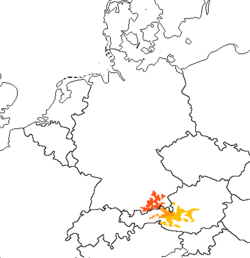Vaand
| Vaand language | |
|---|---|
| dà Vaandülg | |
 | |
| Pronunciation | [/ˈvaːn.dʉlg/] |
| Created by | Raistas |
| Setting | parallel Earth |
| Ethnicity | Carpathian people |
| Native speakers | 220 000 (2012 census) |
Early forms | Proto-Oronaic
|
The Vaand language (native name - dà Vaandülg) is one of the last two Alpian languages spoken by the Vaan people in Austria. It has approximately 220 000 native speakers (including speakers of North Vaand).
In the medieval times Vaand was dialectally diverse consisting of at least three major dialectal groups, however only two distinct dialects have survived to present days. Vaand is written in the Latin alphabet and in general is very similar to German alphabet which it has evolved from.
Linguistically Vaand is classified as a nominative-accusative language. Its phonology is similar to the phonology of neighbouring Austrian dialects of German, that influenced Vaand during all of its history. It is unique for the Alpian region, since it is a non-Indo-European language and its verb conjugation system is much more complex than in its neighbours. Vaand also has case clitics in nouns and a polypersonal agreement in verbs. Typologically it is between fusional and agglutinative languages and has a complex inflection system for nouns, adjectives, pronouns, numerals and verbs, depending on their roles in the sentence.
History
Phonology
Vowels
There are twenty one vowel, most of which create long-short vowel pairs.
|
| ||||||||||||||||||||||||||||||||||||||||||||||||||||